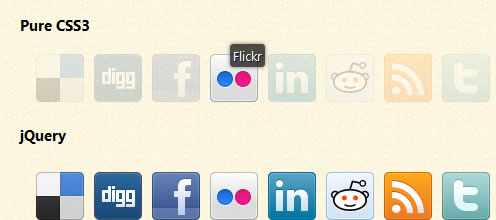Display social icons in a beautiful way using CSS3

When you hover a icon, a small tooltip is displayed with the name of the social media. All other icons have a low opacity.
I wanted to take this concept and bring it to the next level using CSS3 transitions. The goal was to slowly fade-in and fade-out the opacity changing, and animate the position of the tooltip a little bit. With that in mind, I was able to create a beautiful social media icons display using CSS3.
he example works with all -webkit based browsers (Safari and Chrome), but also in Firefox 4. I've included a jQuery version as well, to be used as a form of "backward compatibility". You can also see how the same effect can be achieved using CSS and jQuery.
Although the code and effect is very minimal, it'll give your website a very professional look. Let's dive into the code to see how you can implement something like this on your own website. Take not this effect can be applied to more buttons as well, not only social media icons.
HTML
Our HTML, the backbone of the page, will be very clean and simple (as it should be). Here's a piece of HTML we're going to use.
<ul class="social">
<li class="delicious">
<a href="http://www.delicious.com/">
<strong>Delicious</strong>
</a>
</li>
<li class="digg">
<a href="http://digg.com/">
<strong>Digg</strong>
</a>
</li>
<!-- More services -->
</ul>
As you can see, we use a simply unordered list with list items that contains the links. The only "strange"e; party would be the use of the strong-elements. We need this extra element for some CSS styling of the tooltip. A span-element could be used as well, but I prefer the strong one in this case.
Now let's dive into some generic CSS classes both examples (CSS3 and jQuery) need.
CSS
The basic CSS isn't that hard either. We'll display the list in a row and change some display properties. This is the core of the generic CSS:
.social { list-style:none; }
.social li { display:inline; float:left; }
.social li a { display:block; width:48px; height:48px; position:relative; }
.social li a strong { position:absolute; left:20px; top:-1px;
text-shadow:1px 1px 0 rgba(0, 0, 0, 0.75); background-color:rgba(0, 0, 0, 0.7);
border-radius:3px; box-shadow: 0 0 5px rgba(0, 0, 0, 0.5);
}
li.delicious { background-image:url("../images/delicious.png"); }
li.digg { background-image:url("../images/digg.png"); }
Take note the text-shadow, rgba and border-radius are actually CSS3 properties, but I used them here as well (display of the tooltip). Since the parent of the strong element has a position:relative, we can position:absolute it and use the left and top properties easily.
Now on to the more interesting parts: The CSS3 animation!
CSS3
You might expect some heavy CSS3 going on over here, but that's not true. The syntax of the CSS transition is actually that simply, that it doesn't take that much room! Check it out:
.social:hover li { opacity:0.2; }
.social li { transition-property: opacity; transition-duration: 500ms; }
.social li a strong { opacity:0;
transition-property: opacity, top; transition-duration: 300ms;
}
.social li:hover { opacity:1; }
.social li:hover a strong { opacity:1; top:-10px; }
We simply target a property that should be included in the animation. In our case, that's opacity (for the icon) and opacity, top (for the tooltip). We also set the duration of the animation.
When hovering, we change the values of these properties. Since the transition-property has been set, the browser does all the animation for us! It's as simple as that. When we "hover-out", the classes will be reverted again and the animation can be seen as well.
jQuery
In this case, jQuery can do the job as well (just in case a visitor comes to your website with a browser that doesn't support the CSS3 transition). Although the effect is the same, we do need a lot more code and the jQuery library to be imported. Here's the jQuery code I came up with:
// Hide all the tooltips
$("#jquery li").each(function() {
$("a strong", this).css("opacity", "0");
});
$("#jquery li").hover(function() { // Mouse over
$(this)
.stop().fadeTo(500, 1)
.siblings().stop().fadeTo(500, 0.2);
$("a strong", this)
.stop()
.animate({
opacity: 1,
top: "-10px"
}, 300);
}, function() { // Mouse out
$(this)
.stop().fadeTo(500, 1)
.siblings().stop().fadeTo(500, 1);
$("a strong", this)
.stop()
.animate({
opacity: 0,
top: "-1px"
}, 300);
});
Now all your visitors will be able to see these social icons the beautiful way!
You might also like
Tags
accordion accordion menu animation navigation animation navigation menu carousel checkbox inputs css3 css3 menu css3 navigation date picker dialog drag drop drop down menu drop down navigation menu elastic navigation form form validation gallery glide navigation horizontal navigation menu hover effect image gallery image hover image lightbox image scroller image slideshow multi-level navigation menus rating select dependent select list slide image slider menu stylish form table tabs text effect text scroller tooltips tree menu vertical navigation menu

 Subscribe
Subscribe Follow Us
Follow Us 14 years ago
14 years ago 26546
26546 6356
6356



